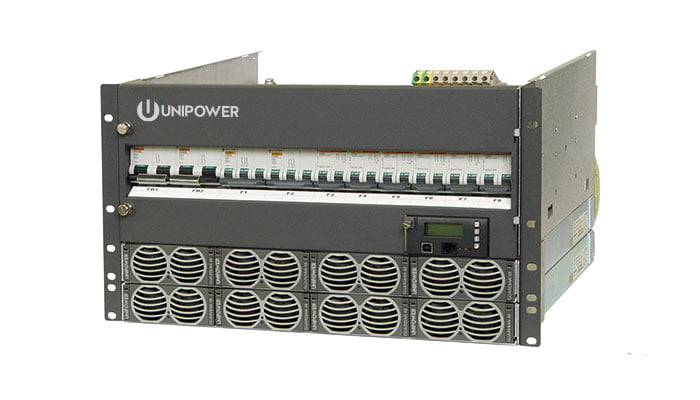Public Safety Communications equipment is at the heart of responding to a myriad of emergencies and typically includes land mobile and microwave radio systems, wireline and wireless telephone systems, mobile computing resources, in-car speed enforcement, emergency and camera equipment.
The lifeblood of this mission-critical equipment is power. If the power equipment is not built to the highest of standards and reliability, power outages and other anomalies could cause major problems – hindering the ability of the police to respond and react quickly. Typically, ensuring that all their AC/DC power equipment is in top working order is the responsibility of telecommunications engineers. One such engineer, Russell E. Wade II, observed, “Power and backup power are critical to run the many microwave and multiplex radios, routers, alarms monitoring and controllers that are the backbone of the statewide public safety radio network. We’re responsible for the communications at the dispatch centers to the patrol vehicles on the highway. If any of this equipment has a power problem, it can be a significant problem if our backup systems are not ready to take the load.”
The Challenge
Oftentimes -48VDC powered Motorola land mobile radios need higher current feeds with “cleaner” connections to enable more flexibility for the required circuits. Older -48VDC power supplies can have a “tedious” bus configuration for feeding the electrical loads. Also, the temperature compensation of the power supplies can become unreliable resulting in battery plant failures. In searching for solutions, Wade worked with Green Cubes technical specialists, David Barnes and Jon Rambin to specify the configuration of the systems.
The Solution
Having experience with Green Cube’s Sageon Micro Series integrated power modules, Wade chose Green Cube’s Guardian Access DC Power Systems that utilize 2.9kW hot-swappable rectifiers fed with 240VAC input circuits. “The Guardian provides a balanced load on our generators and the rectifiers achieve maximum potential output. The chassis can be populated with up to eight rectifiers, providing power ratings far more than what is currently required, to allow for future growth. The output bus can be populated with output breakers ranging from 4A to over 125A, giving us the flexibility for nearly any configuration we may need,” Wade noted.
The highly configurable integrated DC power systems are housed in a 19-inch rack-mounted chassis and provide an output of -48VDC for loads up to 400A. Configured with Guardian rectifiers that boast 96% efficiency, systems can be structured with as many as eight rectifier modules and include a selection of user-specified loads and battery breakers appropriate to system size.
Efficiency and Flexibility
“I also like that the system allows the rectifiers to be put in ‘sleep mode’ when demand is light to conserve energy and extend life. The programming of the controller allows us to customize our alarm outputs and provide exceptionally good temperature compensation to maintain the health of our fixed-site battery plants,” commented Wade. “In addition,
the Guardian’s DIN rail circuit breakers give us tremendous flexibility. The high bus current rating and high-capacity rectifiers provide us tremendous scalability in an N+1 redundant configuration so we always have one rectifier in reserve.”

The Guardians have a small footprint at only 6U high with plenty of power available for most requirements. In the event of a power outage, all the communication sites are backed up with generators along with 48-volt battery banks. “We had a Liebert Nfinity Series UPS which hit its end of life. The power modules that produced the 120VAC from the batteries had a high failure rate,” recalls Wade.
The easy-to-install Guardian Access MS31 units are 5RU or 6RU high 19” rack-mounted, integrated DC power systems providing an output of -48VDC. These systems feature remote monitoring & control and can accommodate highly configurable systems incorporating 2 rectifier shelves with up to 8 Guardian high-efficiency hot-swap rectifiers.
“Several years ago, Motorola came out with a new series of radios that will operate on 48 volts or 120 volts AC. We began to use the Guardians to power the Motorola base radios directly off DC instead of the UPS. Microwave radios, multiplexers, routers, alarms, all run off 48VDC. Because of this, we were able to reduce the load on the Infinity UPSs significantly. Many of our sites are now at just 1 to 2% load. By adding Green Cube’s Bravo Series Inverters to pick up the last items that must run off 120VAC, we are now independent. In the event of a power outage, mostly due to severe weather, our generators will come online in 5 seconds. The 48-volt battery plant associated with the 48VDC power system will carry the entire load and transfer to the generators. If the generators fail, the battery plants are sized so we can stay on the air for several hours.”
Wade appreciates the technical aspects of Guardian systems including their efficiency of 90 to 96%. Of special note is the Guardian’s soft-start capability. In the event of a power outage, when electronic equipment comes back on, it typically comes back hard – all at once – potentially causing power surges. Instead of coming back up at say 60 amps, the Guardian will come back up incrementally for a soft start. Another important feature for Wade is the Guardian’s power supplies. If the control module should fail, the power supplies will continue to produce 48 volts.
The Future
“We are still building out, so we don’t have a large accumulation of data, however so far, we have had zero failures over four years of any of the Guardian products. The reliability and service from Green Cubes have been excellent.”


